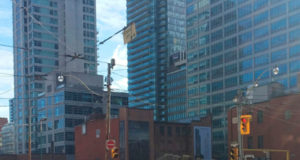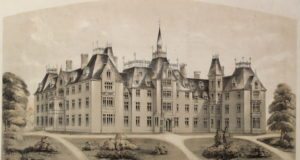Bishop’s Block is on the northeast corner of Simcoe and Adelaide, a block west of University Ave.
When first built in 1829 it was considered the finest apartment building of its day with stores on the ground floor and private residences above. Back then it was also developed on what was the outskirts of town with hope that one day Toronto would expand past York St.
- Built by John Bishop in 1830 his namesake building is one of only a handful of buildings that are older than the city itself (in 1834 the Town of York become the City of Toronto).
- When first built it was considered the finest apartment building of its day with stores on the ground floor and private residences above.
- In the 1970’s the Bishop’s Block’s became the Pretzel Bell Tavern.
- In the 1980’s it was boarded up and for decades to come was left to rot.
- During the construction of the Shangri-La Hotel the Bishop Block was painstakingly disassembled, and then reassembled and is now home to the upscale Soho Club.
- Historic plaque.
Built by John Bishop—a butcher born in London in 1770 who moved to New York first then here—it’s one of only a handful of buildings that is older than the city itself (in 1834 the Town of York become the City of Toronto).
John Bishop settled in the St. Lawrence Market area where he set up shop and proceeded to build a row of houses on Adelaide at Simcoe (then called Newgate and Graves streets) where originally he had five row homes stretching along Adelaide to where University Ave is today.
The block, then the largest row of houses in York, was intended to be first-class residences for gentlemen with the expectation of getting good rents for Bishop.
Of those original five buildings that made up the block only one remains standing. Until recently its fine Georgian detail was hidden for decades beneath a false façade of stucco and faux shutters.
The 1833 town directory lists the top two floors of that remaining building as J. Morgan Gentlemen’s and Families Boarding House.

Anna Jameson (Toronto Public Library/Heritage Toronto)
That lone house that sits at corner of Simcoe and Adelaide streets also has a connection to one of the most remarkable women of the 19th century: Anna Jameson.
Born in Dublin on May 19, 1794, Anna Jameson was the eldest child of Denis Brownell Murphy a miniature painter.
In 1820 Anna was introduced to, and subsequently became engaged to lawyer Robert Jameson. By June 1821 she had broken her engagement and set off for Italy to work as a governess.
A year later she returned and in 1825 she finally married Robert Jameson and had her first major work published: The Diary of an Ennuyée, a fictitious account of her travels in Italy.
In 1833 Robert, then a magistrate, became Speaker of the House of Upper Canada and took up residence in the Bishop’s Block, just a stone’s throw from Parliament which was near present-day Roy Thompson Hall.
In October 1836 Anna arrived in York and immediately couldn’t wait to leave. She stood outside Bishop’s Block and declared to her husband, “I am not living in that!”
In reality the only reason she was coming to York was to obtain a divorce from her spouse who by now was appointed Attorney General of the Province.
Upon her arrival, Anna wrote of her first impression of York: “It is a little, ill-built town, on low land, at the bottom of a frozen bay, with one very ugly church without tower or steeple, some government offices built of staring red brick, in the most tasteless vulgar style imaginable with three feet of snow all around, and the grey, sullen, uninviting lake and the dark gloom of the pine forest bounding the prospect.” A few years later in 1842 Charles Dickens, after visiting Toronto, wrote just the opposite: “The streets are well paved, and lighted with gas; the houses are large and good; the shops excellent.”
In the summer of 1837 Anna made a trip around Lake Huron and published her journey Winter Studies and Summer Rambles in Canada then returned to Toronto where she finally got her divorce then headed off to New York for six months and then finally back to England. Robert and Anna never met again.
But despite her misgivings about Toronto she did have a few admirers here, including 19th-century author and the rector of Holy Trinity Church (still standing behind the Eaton Centre), Henry Scadding who wrote of her: “Intellectually she was an enchantress and her conversation was consequently of the most fascinating kind.”
After her departure Robert maintained his Bishop’s Block residence until his death in 1854. On March 17, 1860, Anna died after a brief illness. Whatever her failings as tourist ambassador for Toronto, Anna did—according to Scadding—write one of the finest accounts of the province in her Winter Studies.
As the decades rolled by the once-fine Bishop’s Block became surrounded by stores, factories, flop houses, all spurred on by the vast growth of Toronto.
In 1936 the remaining Bishop’s Block lost a good portion of its length, along with most of its neighbours, with the construction of University Avenue.
Bishop’s Block’s almost 200-year history could fill volumes, including the time in the early 1970s when it became the Pretzel Bell Tavern (where I had my first beer in Toronto) then was boarded up and for decades was left to rot.
A few years back during the construction of the Shangri-La Hotel optimism prevailed as the Bishop Block was painstakingly disassembled and then reassembled. It stands today as a testament to Toronto’s enduing past while being entirely engulfed by the hotel rising 50 stories above.
Nowadays the restored Bishop Block is home to the upscale Soho Club and from what I could see as I peered through the window, the interior looks absolutely stunning.

This article was originally published in print in the January 2013 edition of The Bulletin. It first appeared online at that time.
 TheBulletin.ca Journal of Downtown Toronto
TheBulletin.ca Journal of Downtown Toronto








